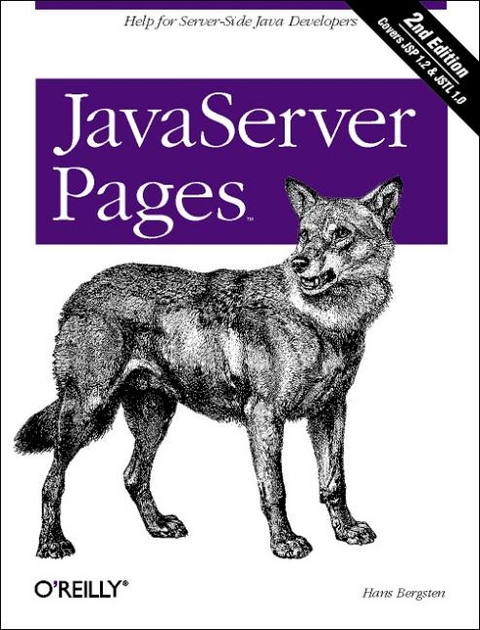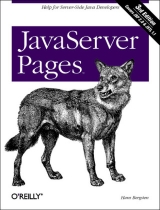
JavaServer Pages
O'Reilly Media (Verlag)
978-0-596-00317-3 (ISBN)
- Titel erscheint in neuer Auflage
- Artikel merken
JavaServer pages (JSP) enable Web developers to combine the flexibility of HTML with the power of Java components to capitalize on dynamic features for Web applications. The simplicity of JSP's component-based model, combined with the cross-platform power of Java, creates a Web development environment with enormous potential. Written by a key contributor not only to the JSP specification, but also to the JSP and Servlet reference implementations, the second edition of this comprehensive guide to JavaServer Pages shows you how to embed server-side Java in to Web pages, while also offering full access to other features such as JavaBeans, Enterprise JavaBeans (EJB), and JDBC database access. In addition, this book covers the new Java Standard Tag Library (JSTL) in detail - in fact, most of the examples are updated to use this new technology from Sun Microsystems, Inc. Filled with examples, this 2nd Edition is completely revised and updated to cover the changes in the 1.2 version of the JSP specifications, and includes coverage of the new JSTL Tag libraries-an eagerly anticipated standard set of JSP elements for the tasks needed in most JSP applications, as well as thorough coverage of
Hans Bergsten is the founder of Gefion Software, as well as author of O'Reilly's JavaServer Pages. As founder at Gefion, his main product is a JSP-based component suite for developing web applications. Hans has been an active participant in the working groups for both the servlet and JSP specifications from the time they were formed, and contributes to the development of the Apache Tomcat reference implementation for both specifications as a member of the Apache Jakarta Project Management Committee.
Preface Part I. JSP Application Basics 1. Introducing JavaServer Pages What Is JavaServer Pages? Why Use JSP? What You Need to Get Started 2. HTTP and Servlet Basics The HTTP Request/Response Model Servlets 3. JSP Overview The Problem with Servlets The Anatomy of a JSP Page JSP Processing JSP Application Design with MVC 4. Setting Up the JSP Environment Installing the Java Software Development Kit Installing the Tomcat Server Testing Tomcat Installing the Book Examples Example Web Application Overview Part II. JSP Application Development 5. Generating Dynamic Content Creating a JSP Page Installing a JSP Page Running a JSP Page Using JSP Directive Elements Using Template Text Using JSP Action Elements 6. Using JavaBeans Components in JSP Pages What Is a Bean? Declaring a Bean in a JSP Page Reading Bean Properties Setting Bean Properties 7. Using Custom Tag Libraries and the JSP Standard Tag Library What Is a Custom Tag Library? Installing a Custom Tag Library Declaring a Custom Tag Library Using Actions from a Tag Library 8. Processing Input and Output Reading Request Parameter Values Validating User Input Formatting HTML Output 9. Error Handling and Debugging Dealing with Syntax Errors Debugging a JSP Application Dealing with Runtime Errors 10. Sharing Data Between JSP Pages, Requests, and Users Passing Control and Data Between Pages Sharing Session and Application Data Online Shopping Memory Usage Considerations 11. Accessing a Database Accessing a Database From a JSP Page Validating Complex Input Without a Bean Using Transactions Application-Specific Database Actions 12. Authentication and Personalization Container-Provided Authentication Application-Controlled Authentication Other Security Concerns 13. Internationalization How Java Supports Internationalization and Localization Generating Localized Output A Brief History of Bits Handling Localized Input 14. Working with XML Data Generating an XML Response Transforming XML into HTML Transforming XML into a Device-Dependent Format Processing XML Data 15. Using Scripting Elements Using page Directive Scripting Attributes Implicit JSP Scripting Objects Using Scriptlets Using Expressions Using Declarations Mixing Action Elements and Scripting Elements Dealing with Scripting Syntax Errors 16. Bits And Pieces Buffering Including Page Fragments Mixing Client-Side and Server-Side Code Precompiling JSP Pages Preventing Caching of JSP Pages Writing JSP Pages as XML Documents How URIs Are Interpreted Part III. JSP in J2EE and JSP Component Development 17. Web Application Models The Java 2 Enterprise Edition Model The MVC Design Model Scalability 18. Combining JSP and Servlets Servlets, Filters, and Listeners Picking the Right Component Type for Each Task Initializing Shared Resources Using a Listener Access Control Using a Filter Centralized Request Processing Using a Servlet Using a Common JSP Error Page 19. Developing JavaBeans Components for JSP Beans as JSP Components JSP Bean Examples Unexpected Behavior 20. Developing Custom Tag Libraries Tag Extension Basics Developing a Simple Action Developing an Iterating Action Processing the Action Body Handling Exceptions The Tag-Handler Life Cycle and What It Means to You Creating the Tag Library Descriptor Packaging and Installing a Tag Library 21. Advanced Custom Tag Library Features Developing Cooperating Actions Validating Syntax Using a Listener in a Tag Library Dynamic Attribute Values and Types 22. Integrating Custom Code with JSTL Using the Expression Language in Custom Actions Setting and Using Configuration Variables Integrating Custom Conditional Actions Integrating Custom Iteration Actions Integrating Custom I18N Actions Integrating Custom Database Actions Using JSTL Tag Library Validators 23. Database Access Strategies JDBC Basics Using Connections and Connection Pools Making a Connection Pool Available to Application Components Using a Generic Database Bean Developing Application-Specific Database Components Part IV. Appendixes A. JSP Elements Reference B. JSTL Actions and API Reference C. JSTL Expression Language Reference D. JSP API Reference E. Book Example Custom Actions and API Reference F. Web Application Structure and Deployment scriptor Reference Index
| Erscheint lt. Verlag | 1.10.2002 |
|---|---|
| Zusatzinfo | index |
| Verlagsort | Sebastopol |
| Sprache | englisch |
| Maße | 178 x 233 mm |
| Gewicht | 952 g |
| Einbandart | kartoniert |
| Themenwelt | Mathematik / Informatik ► Informatik ► Programmiersprachen / -werkzeuge |
| Mathematik / Informatik ► Informatik ► Web / Internet | |
| ISBN-10 | 0-596-00317-X / 059600317X |
| ISBN-13 | 978-0-596-00317-3 / 9780596003173 |
| Zustand | Neuware |
| Informationen gemäß Produktsicherheitsverordnung (GPSR) | |
| Haben Sie eine Frage zum Produkt? |
aus dem Bereich



